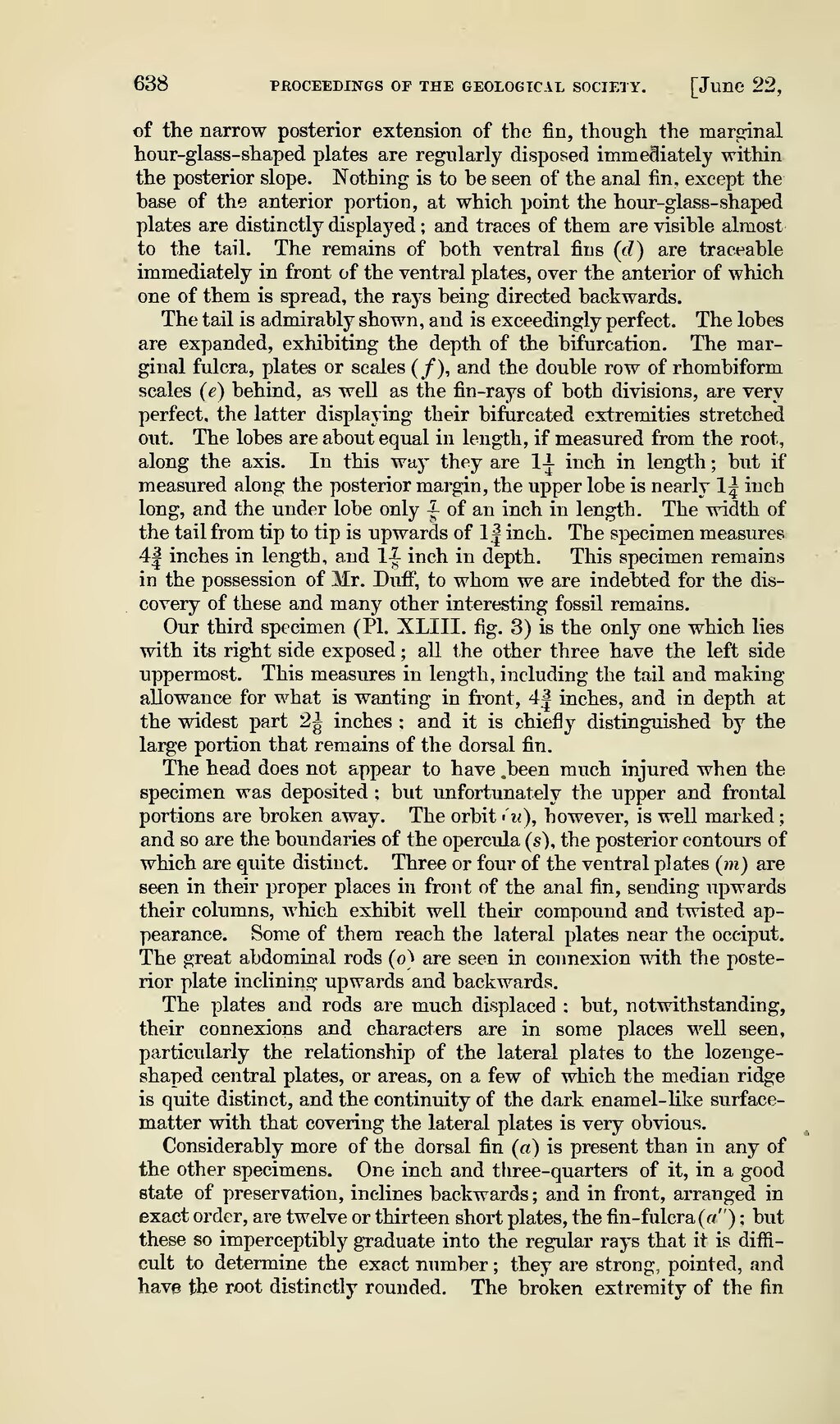of the narrow posterior extension of the fin, though the marginal hour-glass-shaped plates are regularly disposed immediately within the posterior slope. Nothing is to be seen of the anal fin, except the base of the anterior portion, at which point the hour-glass-shaped plates are distinctly displayed ; and traces of them are visible almost to the tail. The remains of both ventral fins (d) are traceable immediately in front of the ventral plates, over the anterior of which one of them is spread, the rays being directed backwards.
The tail is admirably shown, and is exceedingly perfect. The lobes are expanded, exhibiting the depth of the bifurcation. The mar- ginal fulcra, plates or scales (/), and the double row of rhombiform scales (e) behind, as well as the fin-rays of both divisions, are very perfect, the latter displaying their bifurcated extremities stretched out. The lobes are about equal in length, if measured from the root, along the axis. In this way they are 14- inch in length ; but if measured along the posterior margin, the upper lobe is nearly 1^ inch long, and the under lobe only |- of an inch in length. The width of the tail from tip to tip is upwards of 1| inch. The specimen measures 4| inches in length, and 1-| inch in depth. This specimen remains in the possession of Mr. Duff, to whom we are indebted for the dis- covery of these and many other interesting fossil remains.
Our third specimen (PI. XLIII. fig. 3) is the only one which lies with its right side exposed ; all the other three have the left side uppermost. This measures in length, including the tail and making allowance for what is wanting in front, 4| inches, and in depth at the widest part 2^ inches ; and it is chiefly distinguished by the large portion that remains of the dorsal fin.
The head does not appear to have .been much injured when the specimen was deposited ; but unfortunately the upper and frontal portions are broken away. The orbit >'u), however, is well marked ; and so are the boundaries of the opercula (s), the posterior contours of which are quite distinct. Three or four of the ventral plates (in) are seen in their proper places in front of the anal fin, sending upwards their columns, which exhibit well their compound and twisted appearance. Some of them reach the lateral plates near the occiput. The great abdominal rods (o) are seen in connexion with the posterior plate inclining upwards and backwards.
The plates and rods are much displaced ; but, notwithstanding, their connexions and characters are in some places well seen, particularly the relationship of the lateral plates to the lozenge- shaped central plates, or areas, on a few of which the median ridge is quite distinct, and the continuity of the dark enamel-like surface- matter with that covering the lateral plates is very obvious. Considerably more of the dorsal fin (a) is present than in any of the other specimens. One inch and three-quarters of it, in a good state of preservation, inclines backwards ; and in front, arranged in exact order, are twelve or thirteen short plates, the fin-fulcra (a") ; but these so imperceptibly graduate into the regular rays that it is difficult to determine the exact number ; they are strong, pointed, and have the root distinctly rounded. The broken extremity of the fin
